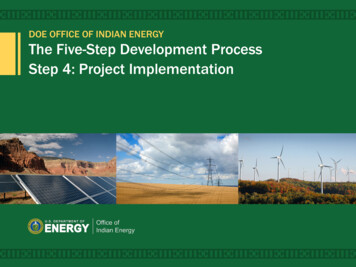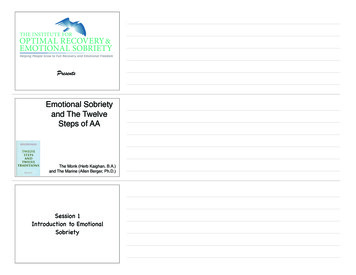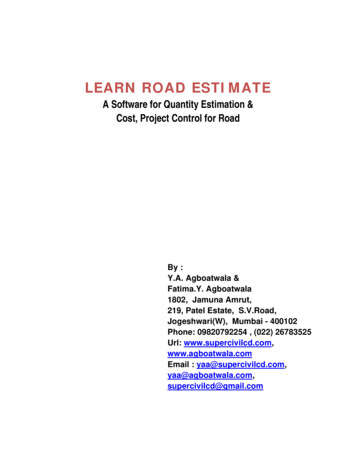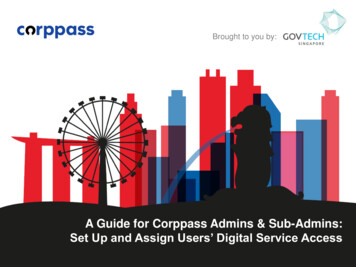
Transcription
DOE OFFICE OF INDIAN ENERGYThe Five-Step Development ProcessStep 4: Project Implementation
Presentation Agenda Step 4: Project Implementation– Pre-construction– Contract execution– Interconnection– Project construction– Commissioning Project Example2
mentation5Operations &Maintenance3
Step 4: tionOperations &MaintenancePurpose: Contract and begin physical construction of projectTasks: Finalize pre-construction activities including project agreements—financial, contractual, and interconnection Realize construction and equipment installation Realize interconnection Realize project commissioning leading to facility/community projectoperationOutput: Completed project (operation)4
Implementation Activities Pre-construction― Financial closing (if applicable)― Project kickoff― Design and construction documents,plans/schedules, submittals Contract execution― Contract oversight/quality control― Change control Interconnection― Application review and approval process― Final building inspection― Paperwork submittal to utility Project Construction― Contract oversight/quality control― Change control Commissioning― Testing and verification― Interconnection verification (utility)― Utility permission to operate5
Pre-construction: Financial ClosingThe process of completing all project-related financial transactions,finalizing and closing the project financial accounts, disposing of projectassets, and releasing the work site.A few key steps: Establish and communicate final date for all financial transactions andaccount closings well before closing Verify all items from the statement of work have been completed beforedisbursing final payments Collect all financial records and verify that all financial obligations havebeen satisfied Close all financial accounts Transfer or dispose of assets according to the acquisition plan.6
Pre-construction: Project Kickoff and Design andConstruction Documents Kickoff meeting Checklists for schedules and each activity based on contract andproject documents Utility interconnection process and agreement Design (often in stages) and design approvals Other possible gementQuality controlCommissioningEnvironmental protectionSecurity7
Contract Execution Verify contract documentation Obtain contract approvals Book the contract Transfer project responsibility to project manager8
Interconnection Installing a renewable energy project requires multiple approval and process steps, includinglocal permitting jurisdiction, installer, and utility. Four distinct steps:1.2.3.4.Utility interconnection application review and approval processConstructionFinal building inspection and paperwork submittal to utilityUtility permission to operate Usually takes approximately 15–20 days for residential and/or small commercial projects. Typically, one must obtain a building permit from the local jurisdiction and sign aninterconnection agreement with the local utility.Process for PV Building Permitting and Interconnection ExampleRetrieved from Ardani et al., “A state-level comparison of processes and timelines for distributed photovoltaic interconnection in the United States.” http://www.nrel.gov/docs/fy15osti/63556.pdf9
Interconnection cont. Utilities prefer installers to submit an applicationfor interconnection early on in projectdevelopment before construction Some utilities are allowing systems that are 30kW or less to be fast-tracked without any preconstruction utility application reviews orapprovals Smaller systems pose fewer risks of adversesystem impacts Different utilities have different thresholds (i.e.,system sizes) for modeling and mitigation10
Project Construction The system has received building approval from the localpermitting authority housing jurisdiction, but has not yetreceived final authorization for interconnection orpermission to operate Project developer orders equipment and beginsconstruction or installation Construction manager coordinates work of various trades Close coordination with tenants if site or building isoccupied Frequent communication between all parties to minimizepossible issues11
Commissioning To receive final interconnection authorization from a utility, theinstaller must first submit verification of passed final buildinginspection Project interconnected according to utility interconnectionagreement and utility process Plan may be standardized by developer and technology andmay be refined according to individual system design Witnessing and/or third party independent commissioningmay be stipulated Commissioning– Physical inspection– Component Testing– Whole system performance testing12
Commissioning cont. Once the building inspections and commissioning process arecomplete, all required paperwork is submitted to the utility(e.g., relay settings, as-built drawings, etc.) Upon approval of all paperwork, the utility will likely install anet meter (for net-metered systems) and finally issue apermission to operate letter. After permission is granted, the installer is allowed to energizethe system.13
Commissioning Process ExamplePlanningInvestigationImplementationHand-off andIntegration Determine objectives and strategies Assemble project team Compile and review documentation Conduct site assessment Develop functional test and monitoring plans Analyze test results Compile master list of deficiencies and recommend improvements Implement accepted recommendations Make repairs and improvements Retest and remonitor Fine-tune Present final documentation of commissioning effort14
Project Risk: Community- and ceConstruction/CompletionOperatingRisksRisk AssessmentPost Step 4 Poor or no renewable energy resource assessmentLow; site picked Not identifying or unrealistic estimation of all possible costsLow; detailed model Incorrect estimation of long-term “community” energy useLow; detailed model Utility rules and ability to offset use with centralized productionLow; final projection Structural (e.g. rooftop solar, wind loading, soil conditions)None; addressed Installation safety (e.g., wind tower, hazard)None; addressed Site control for safety/security purposesLow; site secure Tribe-adopted codes and permitting requirementsLow; complete Utility interconnection requirementsNone; complete Capital availabilityNone; finalized Incentive availability riskNone; finalized EPC difficultiesNone; contracted Cost overrunsNone; construction complete Schedule Output shortfall from expected Technology O&MAssumed low, mitigable orallocatable*NOTE: Underlining signifies that the risk assessment outcome changes during the step at hand.Adapted from Holland & Hart, RE Project Development & Finance & Infocast, Advanced RE Project Finance & Analysis15
presentation on renewable energy project implementation Keywords: doe, us department of energy, office of indian energy, indian energy, community-scale workshop, tribal renewable energy regional workshop, oklahoma, national renewable energy laboratory, project implementation, step 4, five-step development process Created Date: 6/17/2015 1:25:07 PM










